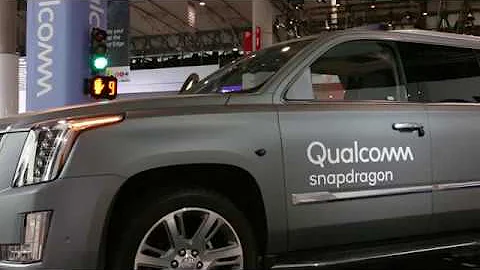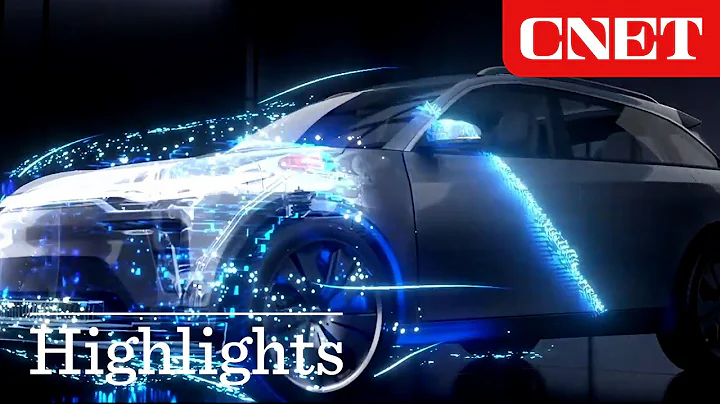Recently, Qualcomm launched the new Qualcomm Snapdragon Ride platform at the 2020 International Consumer Electronics Show (CES 2020), expanding the company's extensive automotive product portfolio. It is reported that the platform is one of the automotive industry's most advanced and scalable open autonomous driving solutions, including Snapdragon Ride safety system-on-chip, Snapdragon Ride safety accelerator and Snapdragon Ride autonomous driving software stack.

With high-performance and energy-efficient hardware, industry-leading AI technology, and groundbreaking autonomous driving software stack, Snapdragon Ride can provide a complete, cost-effective and energy-efficient system-level solution for autonomous driving and ADAS (advanced driver assistance systems).
Snapdragon Ride provides car manufacturers with a scalable solution through a unique combination of SoC, accelerator and autonomous driving software stack - capable of supporting three segments of the autonomous driving system , namely: L1/L2 Level active safety ADAS - for cars with automatic emergency braking, traffic sign recognition and lane keeping assist; L2+ level "convenience" ADAS - for autonomous driving on highways, self-parking, and the ability to Cars that drive in urban traffic environments with frequent stops; L4/L5 level fully autonomous driving - for autonomous driving, robot taxis and robot logistics in urban traffic environments. The
Snapdragon Ride platform is built on a series of different Snapdragon automotive SoCs and accelerators, using scalable and modular high-performance heterogeneous multi-core CPUs, energy-efficient AI and computer vision engines, and industry-leading GPUs. Based on different combinations of SoCs and accelerators, the platform can be matched according to the needs of each market segment of autonomous driving and provide industry-leading cooling efficiency, including from 30 TOPS-level equipment for L1/L2-level applications to A device with L4/L5 level driving and over 700 TOPS power consumption of 130 watts. Therefore, the platform can support passive or air-cooled heat dissipation designs, thereby reducing costs, improving reliability, eliminating the need for expensive liquid cooling systems, simplifying vehicle design, and extending the driving range of electric vehicles. Snapdragon Ride’s family of SoCs and accelerators are designed for functional safety ASIL-D (Automotive Safety Integrity Level D) systems.
It is reported that Snapdragon Ride will be delivered to automakers and first-tier suppliers in the first half of 2020 for early development. Qualcomm expects cars equipped with Snapdragon Ride to enter production in 2023.
Nakul Duggal, senior vice president of product management at Qualcomm, said: "In the past few years, we have demonstrated the company's technological strength in the automotive field through the large-scale deployment of solutions, namely Qualcomm's digital cockpit and connectivity for almost all types of cars. Automotive solutions are capable of delivering high performance and high intelligence in power-constrained environments. Now, we are pleased to introduce the first generation of Snapdragon Ride platform as a highly scalable, open, fully customizable and highly optimized for power consumption. An autonomous driving solution that can meet a range of needs from New Car Assessment Program (NCAP) to L2+ highway autonomous driving to robot taxis by integrating the Snapdragon Ride autonomous driving software stack with automaker first-tier suppliers. Combined with autonomous algorithms, our platform aims to accelerate the deployment of high-performance autonomous driving in the Volkswagen automotive market. In the past few years, we have been developing a new autonomous driving platform and supporting driving stack to determine what the challenges and difficulties are. and gain insights through data analysis to solve the complex problems that automakers care about.”

Industry-leading security SoC and accelerator software and hardware solutions
Qualcomm believes that the next innovation in the automotive field is expected to be L2+ “convenience” ADAS. , and regulatory regulations have also prompted the hardware solutions in the Snapdragon Ride platform to evolve from a single SoC for active safety ADAS systems to a highly scalable architecture consisting of multiple SoCs and dedicated autonomous driving accelerators to support fully autonomous driving system.
Qualcomm's ADAS SoC series and accelerator series use heterogeneous computing, fully considering the application needs at the beginning of the design.Utilizing Qualcomm's next-generation artificial intelligence engine, the above-mentioned ADAS SoC and accelerator can efficiently manage large amounts of data in vehicle systems, including ISP for camera sensors, enhanced DSP for sensor signal processing, high-performance CPU for planning and decision-making, and support Cutting-edge GPUs for high-end visualization and immersive user experiences, dedicated safety and security subsystems across SoCs and autonomous driving accelerators. With the Autonomous Driving Accelerator, Qualcomm brings energy-efficient computing capabilities to mainstream vehicles, equivalent capabilities that are currently far from being supported by the automotive industry due to highly complex and expensive cooling solutions that cannot be scaled due to stringent power requirements. the spread of culture.
launches Snapdragon Ride autonomous driving software stack
Qualcomm’s new software stack specifically for autonomous driving is a modular and scalable solution integrated into the Snapdragon Ride platform, designed to help automakers and first-tier suppliers accelerate development and innovation. The software stack enables automakers to bring greater safety and comfort to everyday driving with software and applications optimized for complex use cases, such as autonomously guided human-like highway driving, as well as providing perception, localization, sensor fusion and modular options such as behavioral planning. The Snapdragon Ride platform's software framework supports the simultaneous hosting of customer-specific software stack components and Snapdragon Ride autonomous driving software stack components.
Qualcomm's integrated automotive platform enhances the company's leadership and drives business growth in the fields of in-vehicle information processing, information audio and video, and in-car interconnection. The total value of orders in these fields currently exceeds US$7 billion. As the industry's leading supplier of in-vehicle information processing and automotive Bluetooth connection semiconductors, Qualcomm has won information audio and video and digital cockpit projects from 19 of the world's leading 25 automakers. At present, all major automakers in the world have adopted Qualcomm’s rich automotive solutions for in-vehicle information processing, information audio and video, and in-car interconnection. They are also working with Qualcomm to deliver safe, reliable and efficient automotive solutions including the Snapdragon Ride platform. .
Snapdragon Ride brings Qualcomm's technical expertise to the automotive ecosystem, meeting the standards of the automotive industry and its infrastructure for secure software and hardware.
Chet Babla, Vice President of Automotive Business, Automotive and IoT Division, Arm Collaboration, and integrating Arm’s functional safety solutions into the Snapdragon Ride platform is an example of improving autonomous driving safety,” said John Koeter, senior vice president of Intellectual Property Marketing and Strategy at Synopsys: Investments in ISO 26262 certification, AEC Q100 and quality management intellectual property simplify the development of next-generation ADAS with Synopsys’ automotive-grade DesignWare interface IP, ARC processor IP, and STAR Memory System and Snapdragon Ride platforms. "The combination will help Qualcomm achieve a high level of functional security and accelerate the certification of its SoCs," said John Wall, senior vice president and co-general manager of BlackBerry QNX: "BlackBerry QNX is very pleased to work with Qualcomm and the Snapdragon QNX OS. The Safety Edition and QNX Hypervisor Safety Edition can provide a safe, secure and reliable software foundation for autonomous driving platforms. As Qualcomm further expands its product layout in the autonomous driving field, we also look forward to deepening our cooperation and embracing new opportunities."
Ritesh Tyagi, general manager of the automotive business at Infineon’s Silicon Valley Innovation Center, said: “Infineon has always been committed to delivering core semiconductor technologies that make cars safer, smarter and greener. Our AURIX™ microcontrollers incorporate the company’s expertise in Expertise in trusted computing, a building block in safety-critical automotive applications, Infineon and Qualcomm collaborate to design and deliver reliable, scalable and energy-efficient computing systems that will help drive the adoption of highly automated vehicles more broadly. Market implementation deployment."We are pleased to collaborate with Qualcomm to develop a new generation AUTOSAR architecture that integrates EB corbos software and the Snapdragon Ride platform that can scale to meet customer needs," said Artur Seidel, Vice President of Americas at
Elektrobit. Our products powered by Qualcomm technology will allow Tier 1 suppliers and automakers to introduce ADAS into production vehicles faster and more efficiently. "
Ross Jatou, vice president and general manager of the Automotive Sensing Division of ON Semiconductor, said: "ON Semiconductor is pleased to integrate our ADAS series of sensors into the Snapdragon Ride platform. By working closely with Qualcomm, our ADAS sensors are able to achieve seamless and robust interoperability with Qualcomm's processors and software, helping automakers and Tier 1 suppliers quickly and cost-effectively launch next-generation solutions. In addition, the flexible addition of in-car functions such as driver monitoring and in-car monitoring in information, audio and video digital cockpits and autonomous driving systems will also significantly accelerate the popularization of these new safety and convenience functions. "
Editor: Hua Zheng
Copyrighted works are strictly prohibited from being reproduced without written authorization from Huanqiu.com, and violators will be held legally responsible.





















